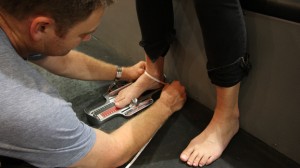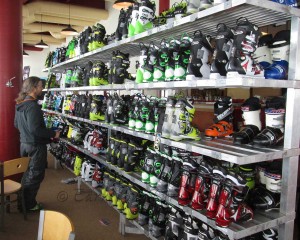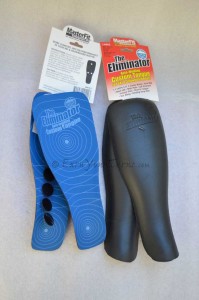Because of the inherent stiffness of a ski boot you are simply unlikely to ever feel that. And since ski boots are modular, with a liner and a shell, a lot can get lost in translation. Ski manufacturers try to overcome with liners that give you the sensation of adequate pressure all around, but it tends to also blur perception. That’s where a good bootfitter can help, but it also helps to learn what zones to pay attention to.
Volume means 3 dimensions

Getting the right fit means measuring your foot in 3 dimensions, not just the typical two (length X width).
Even though the length and width are indicative of a foots overall volume, the more dominant indicator is the height of the instep. In fact, until you factor in this value, you have only accounted for the size of a footprint, essential a 2-dimensional object. To get volume, you need three dimensions.
In fact, since within a given size the length is constant, and the width typically only varies 8mm (max), the height has a large influence in boot volume. The other factor involved here is the strategic location of the instep as a place to secure a foots position in a boot. If the instep is not held down firmly, a foot can easily lift causing blisters on the heel when touring, and/or slide forward because it can, banging your toes on the end with a myriad of symptoms resulting for that.
This is the most misunderstood part of getting a good fit. Length can be too long if you can hold your heel in the rear pocket of the shell, and sides can be filled if there’s too much room width wise, or punched if not enough. However, changing the volume of a shell over the instep, while possible, is better done by getting the proper match out of the box.
The Instep – the roof of your foot
First, a little clarification on the instep. It is not your arch, or the top of your arch although people with a high arch do tend to have a high instep. On the flip side a low arch does not reliably indicate a low instep. Rather it is the top of your foot, above the arch, where the foot meets the lower leg, also known as the anterior ankle. Structurally speaking this is just above where the navicular bone is located.
The instep is not measured by the direct height, but rather, by circumference – from one side of the back of your heel, around and over the instep, and back to the other side. If that distance is about the same length in centimeters as your mondo size, in other words ~26.5 cm for a mondo 26.5 boot, you have an average height instep. A low instep would be less than 25.5 in this case, a high instep would be more than 27.5.
And yes, there is a correlation generally between wider feet and higher insteps, which is why folks with wide feet do tend to have high volume feet, and thus why wide boots tend to be high volume boots. But a thin foot with a high instep will generally fit a high volume boot better than one matching the width of the foot.
While boots can be punched for things like bunions to increase width, it is difficult to expand volume above an instep since many boots utilize an overlap cuff, which always wants to take up volume, not expand it. It can be done, but not with consistent results. It is much easier to take up volume over the instep with additional padding.
Filling the Void
While helping with boot fitting at Backcountry Magazines annual gear test we weren’t in a position to be making shell modifications, but when there was a problem with fit the solution was to get a boot with enough room in the toe to be comfortable, and then fill the space over the instep with a tongue shim. It’s just a strip of 6mm foam with a nylon face fabric against your leg. We used double-sided carpet tape to hold ’em in place. For a day or two that’s good enough.There is also a commercial product available that does the same thing, called the Eliminator from Masterfit Enterprises, Inc. It is a molded piece of foam shaped to conform to the inside of nearly any tongued ski boot liner. A pair come with half a dozen velcro tabs to hold it in place to your existing liner. As should be evident, it works best with tongued liners, not wrap-around liners.
Next time you’re in the market for a new pair of boots, or your current boots are not fitting well, find a good local bootfitter and work with him/her to resolve your problem. It might be as simple as adding a tongue shim. It might not. Knowing a bit about the bootfitting process can help you give accurate feedback to a good bootfitter and help you get a better fitting boot.
Masterfit Enterprises
The Eliminator
MSRP: $30
Sizes: Small (22-25 mondopoint), Large (> 25.5 mondopoint)
© 2014
Related Links:
America’s Best Bootfitters



2 comments
1 ping
Craig, thanks again for fitting me up the right way—it made a very noticeable difference in the few days I had left to ski and really hoping, praying that this season turns out to be a good one so I can again benefit from your help.
Very good article.I tried on many many shop pairs, chose Salomons Xmax 130 with standard (soft) footbed, best snuggest fit all around ankle i could get, thought all OK, no GREAT actually.Then got a sidas footbed which didn’t allow much arch flattening and now lose sensation / get numbness in feet. Salomon appears much shallower over foot than i’ve had previously. Ankle heel, over / around instep to ankle heal measures 30cm, length measures 27.5. I have therefore a ‘high’ volume foot which i never knew before. Have to go back to the standard soft footbed – suspect i’ll be in different boot very soon. So next time i’ll be trying on boots with ‘my’ footbeds in place (if allowed).
[…] on this link to see a great earnyourturns.com article on ski boot fit, volume and how professional bootfitters […]